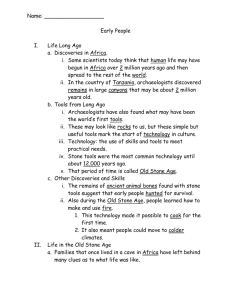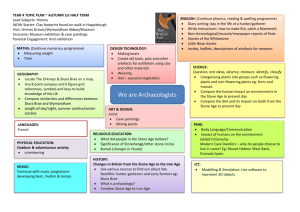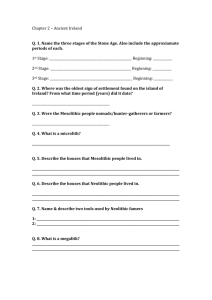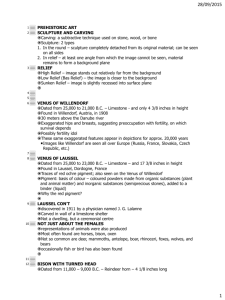Arch 1 Chapter 2
advertisement
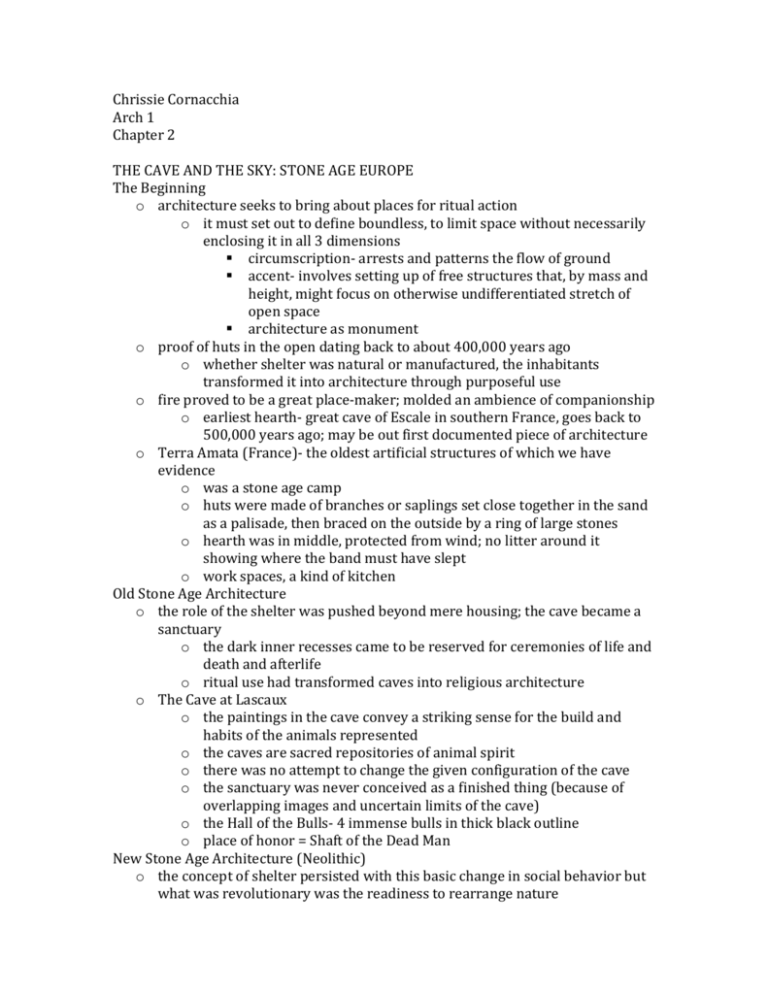
Chrissie Cornacchia Arch 1 Chapter 2 THE CAVE AND THE SKY: STONE AGE EUROPE The Beginning o architecture seeks to bring about places for ritual action o it must set out to define boundless, to limit space without necessarily enclosing it in all 3 dimensions circumscription- arrests and patterns the flow of ground accent- involves setting up of free structures that, by mass and height, might focus on otherwise undifferentiated stretch of open space architecture as monument o proof of huts in the open dating back to about 400,000 years ago o whether shelter was natural or manufactured, the inhabitants transformed it into architecture through purposeful use o fire proved to be a great place-maker; molded an ambience of companionship o earliest hearth- great cave of Escale in southern France, goes back to 500,000 years ago; may be out first documented piece of architecture o Terra Amata (France)- the oldest artificial structures of which we have evidence o was a stone age camp o huts were made of branches or saplings set close together in the sand as a palisade, then braced on the outside by a ring of large stones o hearth was in middle, protected from wind; no litter around it showing where the band must have slept o work spaces, a kind of kitchen Old Stone Age Architecture o the role of the shelter was pushed beyond mere housing; the cave became a sanctuary o the dark inner recesses came to be reserved for ceremonies of life and death and afterlife o ritual use had transformed caves into religious architecture o The Cave at Lascaux o the paintings in the cave convey a striking sense for the build and habits of the animals represented o the caves are sacred repositories of animal spirit o there was no attempt to change the given configuration of the cave o the sanctuary was never conceived as a finished thing (because of overlapping images and uncertain limits of the cave) o the Hall of the Bulls- 4 immense bulls in thick black outline o place of honor = Shaft of the Dead Man New Stone Age Architecture (Neolithic) o the concept of shelter persisted with this basic change in social behavior but what was revolutionary was the readiness to rearrange nature o farmland was divided into individual fields, settlements were circumscribed sacred ground was distinguished o monuments made their appearance; stones were raised upright to mark open land = sign points of civilized life megaliths- giant stones that might have been proud symbols of community; brought down on them the sway of the deities o The Houses- settlers normally lived in small individual houses of timber and mud roof was pitched to shed rain and snow, covered with thatch or turf in the north, there were strongly built wooden houses accommodated with a number of families or 1 extended family hearth was in the middle of the long, central space on either side of hearth was divided space to shelter animals o The Monuments- social distinction seems implied in the fact that monumental tombs honored the remains of only some mortals upended (turned over) stones, menhirs, were the simplest form of megalithic monument tallest is the Grand Menhir Brisé in Brittany near Carnac, France there are more than 3,000 megaliths of local granite lined up for several miles in 10-12 rows that run toward a circle o “monumentalized boundaries”, “linear monuments” menhirs’ height and mass made them visible from a distance and encouraged movement towards them directional foci; they represent our first instance of a principle of organizing space rotational foci invites us to move around them; its object is to give people a reference point as they move about an open space o The Tombs-unlike menhirs and their groupings, Neolithic stone tombs were designed as closed spaces dolmen- basic (but not commonest) form is a simple boxlike chambers made up of several upright slabs for walling, with a more or less flat stone on top cyclopean masonry- walls with boulders piled up in irregular courses; relies on the cohesion of many boulders of varying sizes megalithic masonry works with far fewer and larger units; principle is not unlike building a house of cards corbelling- as the structure rises, successive courses are made to project inward, narrowing the circumference of the chamber until the space is totally sealed off vertical stones are set on the end for the walls and horizontal ones that bridge them across space in most cases, the completed tombs were submerged under artificial mounds they mattered as interior spaces, houses of stone for the special dead in the ancient embrace of the earth stability in architecture resided in the studied equilibrium of load and support the accidental drama of megalithic tombs as they stand denuded in the landscape illustrates stability on the verge of being upset o The Temples of Malta o the complex at Ggantija, “Tower of the Giants” is one of a number of prehistoric temple structures peculiar to the Maltese islands o built of local stone, using a mixture of megalithic and cyclopean techniques; walls consist of double shell filled with earth and rubble; exterior shell uses coralline (limestone) the exterior was considered secondary without suggesting much of its inner organization o experience of temple concentrated on an enclosed space furnished and decorated in accordance with the needs of an intricate cult o chambers were accepted as they were found, and then defined ritually o first true building type we are encountering (an architectural form that is invented for a specific purpose and achieves a general validity, both visual and ritual, through its repeated use) o the inner shape stands as the architectural metaphor for the obese mother goddess of the caves; animal sacrifice was a main observance o monumental entrances- “gates of horn” o in these deep sanctuaries, the Neolithic people carried on its sacred rites of pacifying the dead and assuring fertility o Stonehenge o haunting circle in the chalk uplands of southern England o Aubrey holes (hold proof of ceremonial burials (secondary function) o the early Briton builders’ involvement was with the sun an0d the moon (their aim was to recognize and celebrate heavenly events) o first stage of building was the earth circle, broken at one place o sun rises over the Heel Stone o in the middle of the circle is a double ring of bluestones brought all the way from Wales o sarsens were tilted into a ring of pits; sarsen horshoe was completed with 6 trilithons (opened up toward the avenue and the sacred path of the mid-summer rise)


